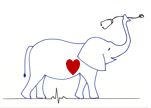Congestive Heart Failure Quiz
1. Which of the following would not be an expected sign of right-sided congestive heart failure?
a. Prominent jugular vein
b. Hepatomegaly
c. Pulmonary edema
d. Pleural effusion
Answer
2. Which statement is true regarding Starling’s law of the heart?
a. Decreased preload leads to increased stroke volume and decreased contractility
b. Increased preload leads to increased stroke volume and increased contractility
c. Increased preload leads to decreased stroke volume and increased contractility
d. Decreased preload leads to decreased stroke volume and increased contractility
Answer
3. Which of the following is not a result of activation of the intra-cardiac renin-angiotensin aldosterone (RAAS) system?
a. Cardiac remodeling
b. Progressive hyperplasia
c. Progressive hypertrophy
d. Fibrosis
Answer
4. Which of the following regarding ADH (vasopressin) is true?
a. ADH is released from the anterior pituitary
b. Mediates potent vasodilation via V1 receptors in the blood vessels
c. Mediates increased insertion of aquaporin channels in the collecting ducts via V2 receptors
d. Release is triggered by increased effective circulating volume
Answer
5. Which of the following is true regarding catecholamine toxicity to the heart?
a. Decreases the myocardial oxygen demand (MVO2)
b. Causes an intracellular calcium overload
c. Slows the heart rate
d. Reduces the tendency toward arrhythmia
Answer
6. Which of the following is false regarding the role of the vasculature in CHF?
a. Endothelins are potent vasoconstrictors
b. Nitric oxide (NO) is important in normal vasodilation
c. CHF causes increased release of natriuretic peptides which originate predominantly from the endothelium
d. Endothelin release contributes to increased afterload
Answer
7. Which of the following is false regarding the long-term effects of TNF-a?
a. Increases inotropy
b. Drives cardiac remodeling
c. Contributes to cachexia
d. Increases inflammation
Answer
8. Which of the following is true regarding the natriuretic peptides?
a. Contribute to balanced vasoconstriction
b. Promotes sodium retention
c. Increases vasopressin (ADH) release
d. Antagonizes the sympathetic nervous system (SNS)
Answer
9. A 4-year old neutered male DSH with a known history of hypertrophic cardiomyopathy, or HCM, presents for an echocardiogram. You see this view, shown below, from an end-diastolic picture. How would you explain these findings?

a. There is concentric hypertrophy of the left ventricle, the hallmark finding in hypertrophic cardiomyopathy
b. There is eccentric hypertophy of the right ventricle, which is a classic finding in hypertrophic cardiomyopathy
c. There is concentric hypertrophy of the left atrium, which is the main diagnostic finding in hypertrophic cardiomyopathy
d. There is eccentric hypertrophy of the right atrium, which is a less common finding in hypertrophic cardiomyopathy
Answer
10. Which of the following is true regarding angiotensin-converting enzyme inhibitors?
a. They directly block the sympathetic nervous system
b. Their use results in decreased plasma levels of angiotensin II
c. They are very potent diuretics and this accounts for most of their beneficial effect
Answer
